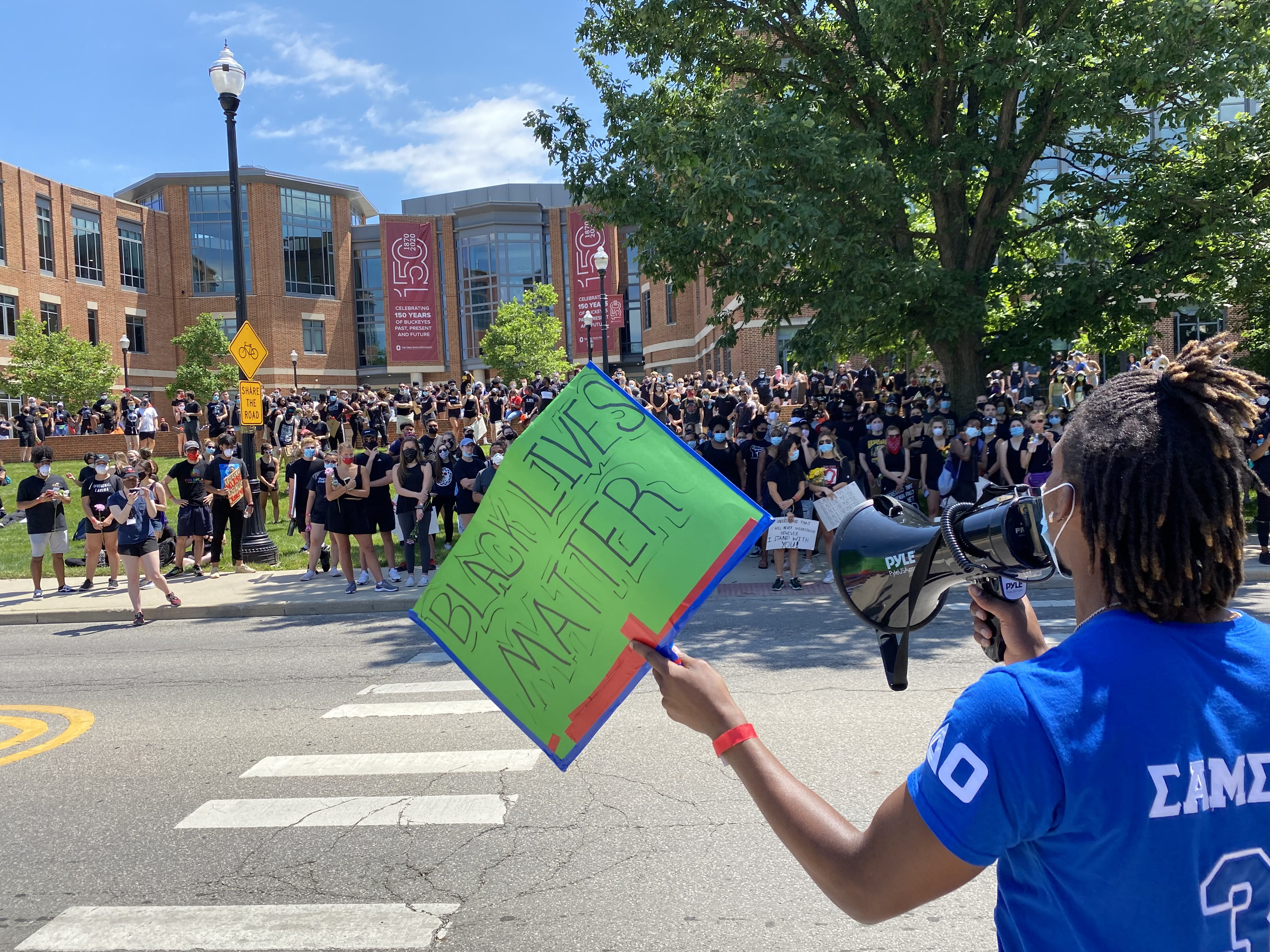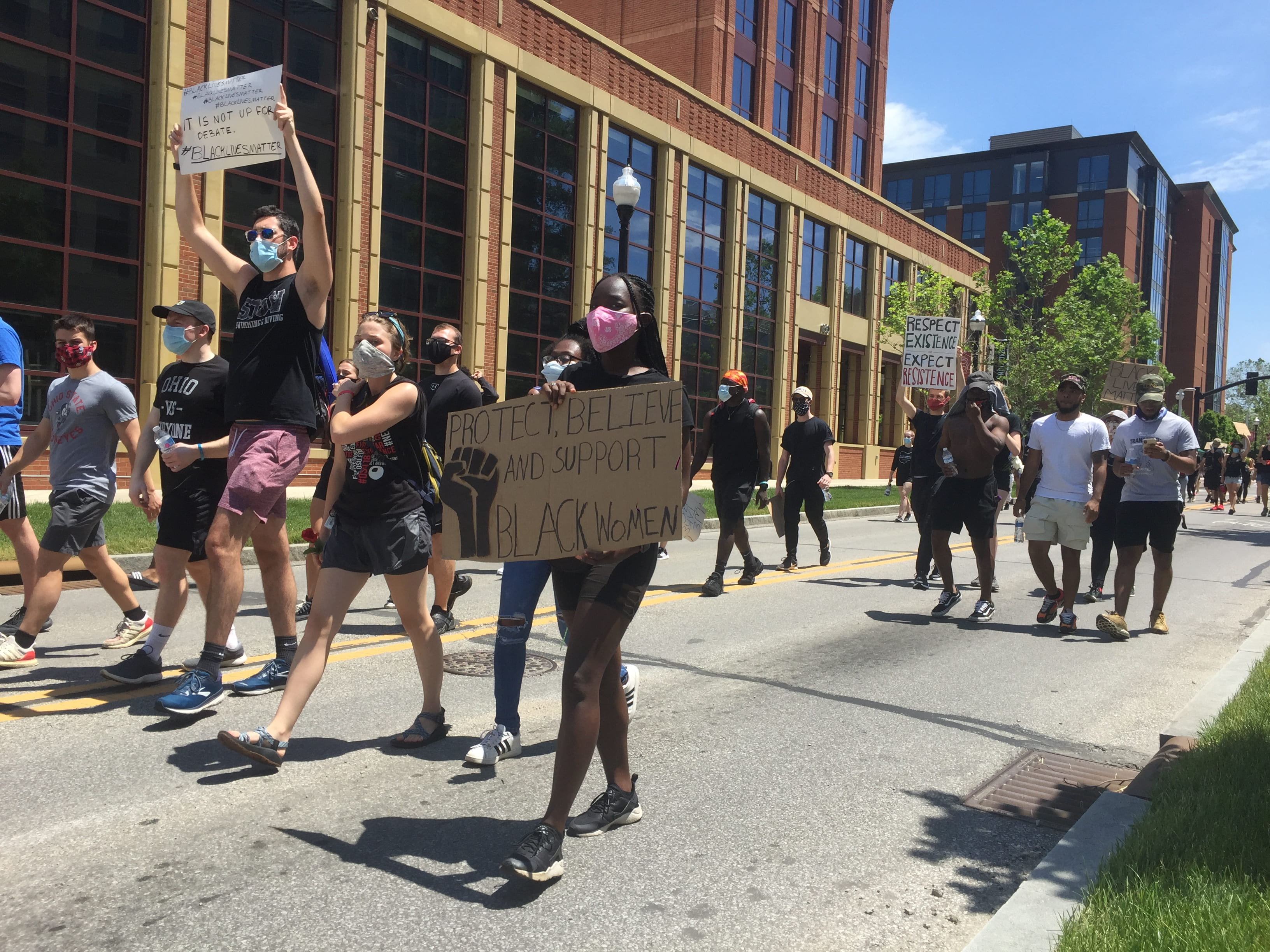Students organize peaceful protest through campus
Sarah Szilagy, Owen Milnes, Maeve Walsh, Sam Raudins and Max Garrison contributed reporting.

Jonathan Graham, a fourth-year in African American and African studies and protest organizer, briefs crowd on safety protocols ahead of the demonstration. Credit: Owen Milnes | Campus Producer
Several dozen student organizations raised more than $1,000 for a campus protest in light of the death of George Floyd and other black Americans due to police use of force.
The protest, which began on the South Oval, marched through campus and ended at Hale Hall, home to the Hall Black Cultural Center, and drew a crowd of more than 350 protesters. Most demonstrators dressed in black — in mourning — and some held flowers and signs.
Yarith Morales, an Ohio State alumna as of May and an organizer of the march, said the idea for the protest began among a group of friends.
“It kind of just grew. Originally it was just supposed to be a protest, organized protest, just on the Oval. It was just supposed to stay there and then somebody was like, ‘Well, how about a march?’” Morales said. “Well then, how about let’s go to a local landmark on campus that says something to the campus?”
Jonathan Graham, a fourth-year in African American and African studies and one of the protest’s organizers, said they decided to end the march at Hale Hall because of its significance to other campus black civil rights movements.
“Every major protest that has involved students of color or [people of color] black students, it always has either — not always, but most of the successful ones have started or ended at Hale Hall,” Graham said.”
Hale Hall was home to the Black Student Union, which was created in fall 1967 following a series of summer meetings among African American students to fight for better treatment of African American students on campus. In 1968, a group now known as the OSU 34 took over the administration building — now Bricker Hall — to protest racial descrimination against black American students. The efforts of the two groups resulted in the hiring of faculty members such as Frank W. Hale, William E. Nelson and Charles Ross, who carried the message of the Black Student Union and challenged the university from an administrative perspective.
Faduma Husan, a fourth-year in public affairs and president of the Public Affairs Multicultural Student Organization, said she is protesting because the police use of force has become a global issue.
“This is not just a citywide thing, it’s not a statewide thing, it’s not a nationwide thing; this is a worldwide thing and this is something that has been going on forever,” Husan said. “This is nothing new, it’s just coming to the forefront now. We’re here in solidarity with everyone who has been affected by police brutality, by racism and anti-black violence.”
Alador Sisay, a fourth-year in biological engineering, had a message for other Ohio State students.
“Get out there. If this is your first time, you haven’t done it before, just try it out. You know, this is a movement and if you’re not fighting, you’re not doing anything,” Sisay said.
The protesters ended their march by gathering in the shade behind Hale Hall to hear speakers and performances. Some, like recent Ohio State grad Kayla Campbell, sang to the crowd. Others, like Lawrence Wiliamson, director of the Office of Diversity and Inclusion and cultural center, elaborated on others’ words of wisdom.
Paraphrasing the words of Martin Luther King Jr., Wiliamson said, “I’ve seen the promised land. I may not get there with you, but one day you will get to the promised land. You all are the promised land. You are the dream.”
Ose Arheghan, a third-year in political science and Chinese, spoke about the letter circulating around campus — now with more than 20,000 signatures — that urges the university to cut ties with Columbus Police.
The open letter, written by the presidents of Ohio State’s Undergraduate Student Government, Council of Graduate Students and Inter-Professional Council, was released Monday and demands the university and University Police cease on-campus operations with Columbus Police and review contracts with Columbus Police for off-campus activities.
“If you’ve not signed it, get the link,” Arheghan said. “As students, it is our job to hold our university accountable when we feel that they are not making decisions that are in our best interest, and so public safety, the safety of black students, the safety of every student cannot happen with Columbus Police Department being on our campus.”

Protesters march west on West Woodruff Avenue past Scott House, led by a University Police vehicle. Credit: Maeve Walsh | John Oller Special Projects Editor
Some speakers spoke more specifically to non-black people in the crowd.
“Allyship is not a business. It does not have an opening time or a closing time,” Jesse Fernandez, a fifth-year in exercise science and member of the Latino Student Association, said.
Hasan Jeffries, an associate professor of history, said that incoming University President Kristina M. Johnson needs to prioritize increasing diversity and divest from the police.
“What are you gonna do for us? What are you gonna do to make it possible for us as a community, what are you gonna do to make it possible for us to breathe here? For us to get an education?” Jeffries said.
Jeffries spoke for more than 20 minutes, asking for Ohio State students to continue to make their voices heard and to support the student government open letter. But he cautioned against looking too far ahead to the future and not acknowledging the current circumstances.
“A lot of people like to quote MLK about him dreaming and color blindness and not talk about the nightmare that we are living in,” Jeffries said. “He had a dream because it was unbearable to live in the nightmare we were living in.”
